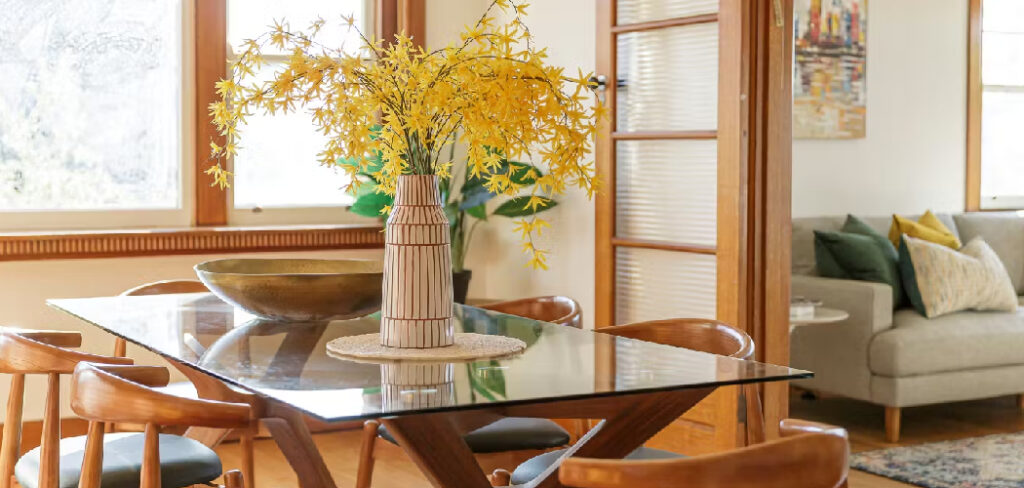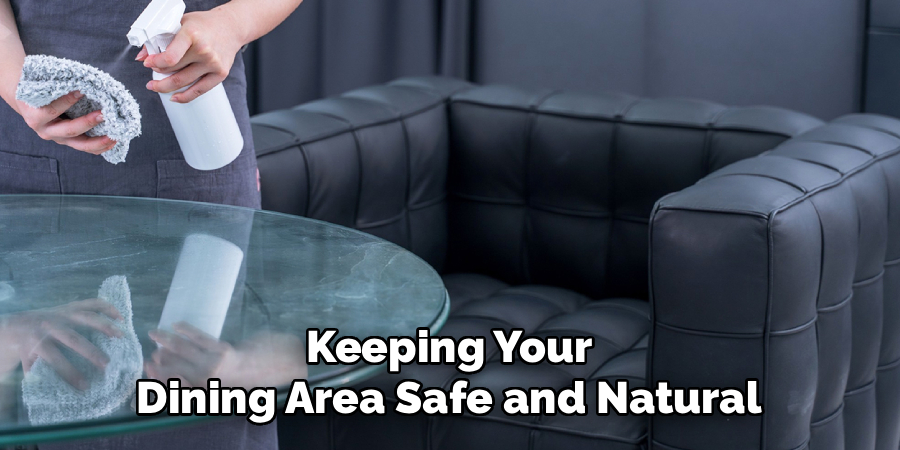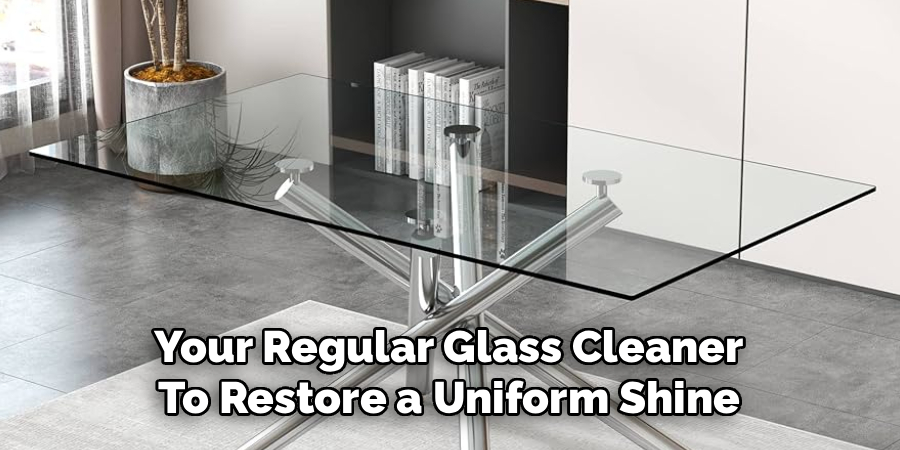A spotless glass dining table instantly adds brightness and elegance to your home, but maintaining that flawless look can feel challenging. Fingerprints, smudges, and streaks tend to appear just minutes after you’ve finished cleaning. The good news is that learning how to clean dining table glass is simple with the right technique.

By using gentle materials and consistent methods, you can restore your tabletop’s crystal clarity in minutes and keep it shining longer. Whether you’re preparing for a dinner party or simply want a polished everyday look, this guide will walk you through an easy, effective process that leaves your glass surface gleaming and streak-free.
The Benefits of a Sparkling Clean Glass Table
A gleaming dining table transforms your space from ordinary to impressive. Beyond looks, cleanliness plays a big role in your dining experience.
When you maintain your glass tabletop regularly, it enhances both hygiene and beauty. Dust and food particles can easily accumulate, creating dull patches and unwanted grime. A clean surface eliminates these irritants, making your dining area more inviting.
Clear glass also reflects light beautifully, making small rooms appear larger and more open. It becomes a natural focal point that highlights your décor and dinnerware. Regular upkeep also prevents etching or permanent marks from spills or acidic substances.
A spotless glass table represents care and attention to detail. It sets the tone for shared meals and gatherings, signaling warmth, organization, and pride in your home.

Tools and Materials You’ll Need
Before you start, gather these items to make the cleaning process seamless and efficient:
- Two Microfiber Cloths – one damp for cleaning, one dry for buffing
- Spray Bottle – for your cleaning mixture
- Distilled Water – to avoid mineral streaks or deposits
- White Vinegar – a natural, streak-free cleaner
- A Soft Brush or old Toothbrush – perfect for crevices and edges
- Small Bowl or Container – to mix your homemade solution
- Optional Squeegee – for large tables and a professional finish
- Mild Dish Soap – to tackle greasy fingerprints
- Essential Oils (optional) – for a fresh, pleasant scent while cleaning
Step-by-Step Guide: How to Clean Dining Table Glass
Step 1: Clear and Prepare the Surface
Start by removing everything from your dining table. Move placemats, centerpieces, or vases so you can access the entire glass area. Then, use a dry microfiber cloth to gently sweep away dust and crumbs. This quick-dry wipe prevents grit from scratching the surface once you apply liquid cleaner. Preparing the surface may seem simple, but it’s crucial—cleaning a dusty table with liquid will only smear dirt around and cause streaks. Make sure the base, especially if wooden or metallic, stays dry to prevent damage. Once the tabletop is fully clear, you’re ready to move to the next step for a truly polished result.
Step 2: Mix Your Homemade Cleaning Solution
A homemade glass cleaner is inexpensive, eco-friendly, and powerful. In a spray bottle, combine equal parts white vinegar and distilled water. The vinegar cuts through grease and residue, while the distilled water prevents streaking. Shake gently to blend. If you dislike the vinegar smell, add a few drops of lemon or lavender essential oil. This mixture dissolves fingerprints and restores shine without harsh chemicals. Avoid using ammonia-based cleaners near wooden frames or fabric chairs, as fumes can cause discoloration. With your DIY solution ready, you’re equipped to clean effectively while keeping your dining area safe and natural.

Step 3: Apply Cleaner Lightly and Evenly
When applying your cleaner, less is more. Hold the spray bottle about six to eight inches away from the surface and mist lightly across one section at a time. Oversaturating the table can cause streaks and dripping, especially along the edges. Work in small areas so the liquid doesn’t dry prematurely. Avoid spraying directly onto decorative wood trims or table legs to prevent moisture damage. The goal is to moisten the glass evenly without flooding it. This method gives you control over each area and ensures consistent results as you clean section by section.
Step 4: Wipe Using a Consistent Motion
After spraying, use your damp microfiber cloth to wipe the surface in a steady motion. Move in an “S” or “Z” pattern, starting from one side and working your way across. This approach helps you cover the glass evenly without pushing dirt around. Avoid circular rubbing, which can create visible swirl marks. If you encounter sticky spots, press the cloth gently and let the cleaner loosen the residue before wiping again. Consistency is key: uniform strokes produce a professional, streak-free finish that catches the light beautifully.
Step 5: Focus on the Edges and Corners
Edges and corners tend to collect dust, crumbs, and fingerprints that are easy to overlook. Lightly spray your cloth—not the table directly—to clean these delicate areas. Wrap your cloth around a finger or use a soft toothbrush to reach tight spaces or intricate designs. Be cautious if your table has a beveled or rounded edge, as excess pressure might cause smudges or drips underneath. A careful, detailed clean around the perimeter gives your glass that extra sparkle and ensures no streaks appear from any angle.

Step 6: Clean the Underside for a Clear View
The underside of a glass dining table often goes unnoticed, but it contributes significantly to overall clarity. Sit or crouch beside the table for easier access, and use the same cleaning method—lightly mist your cloth, not the glass. Wipe in smooth strokes, removing dust or dried spills that might be visible through the surface. Since the underside doesn’t get touched as often, you won’t need to clean it every time. However, addressing it occasionally keeps your table looking crystal clear from above and below, especially in bright lighting.
Step 7: Buff to a High Shine
Immediately after cleaning, grab your second, completely dry microfiber cloth. Buff the glass while it’s still slightly damp to remove moisture and polish the surface. Use long, overlapping strokes, applying gentle but firm pressure. This step transforms a simple clean into a radiant finish. As you move, you’ll notice the cloth gliding smoothly when the area is perfectly dry. For large tables, buffing section by section ensures you don’t miss spots. The reward? A stunning, streak-free glass top that sparkles from every angle.
Step 8: Optional – Use a Squeegee for Large Tables
For oversized dining tables, a squeegee can make the job faster and more precise. After misting your cleaner, start at one edge of the table and pull the squeegee in straight, downward strokes. Wipe the blade with a cloth between passes to prevent streaking. Slightly overlap each stroke for uniform results. This professional method eliminates most moisture in one sweep, leaving minimal buffing afterward. Just remember to wipe any remaining drips along the edges. Once mastered, a squeegee can make your glass table cleaning routine effortless and ultra-efficient.
Step 9: Inspect and Touch Up
Once you’ve finished cleaning, step back and view the table from different angles. Sunlight or overhead lighting often reveals streaks you might miss up close. If you spot one, use your dry microfiber cloth to buff the area until it disappears. Check the base and edges for stray drips or cleaner residue, especially if your table has wooden or metal supports. This final inspection ensures a flawless finish and helps maintain the table’s overall polish. Taking a few extra seconds here guarantees that your dining area always looks photo-ready.
Step 10: Maintain a Routine for Lasting Clarity
The best way to keep your glass dining table looking new is through regular maintenance. Wipe it daily with a dry cloth to remove dust and fingerprints. Do a full clean weekly using your vinegar-and-water solution. After meals, a quick wipe prevents sticky buildup. Consider placing placemats or coasters to protect the surface from scratches. Consistency is everything—by following a simple schedule, your glass will stay spotless and gleaming with minimal effort.

Customization Tips
Tailor your routine to your household’s needs. If your table often gets greasy from food, add one drop of mild dish soap to your vinegar mix for better degreasing. Prefer natural fragrances? Infuse your cleaning solution with citrus peels for a refreshing scent. For tinted or frosted glass, use a softer cloth and less pressure to maintain the surface’s texture. You can even keep a small spray bottle and microfiber towel nearby for daily touch-ups—perfect for busy homes or open dining spaces.
Common Mistakes to Avoid
Even small errors can lead to frustrating streaks or dullness. Avoid these pitfalls:
- Cleaning under direct sunlight—the solution dries too fast, leaving marks.
- Using paper towels or rough fabrics that shed lint or cause scratches.
- Spraying too much liquid, which leads to streaking and drip marks.
- Skipping the buffing step, which prevents that crystal-clear shine.
- Neglecting the edges and underside can dull the overall look.
By steering clear of these mistakes, you’ll extend your table’s clarity and reduce cleaning time.
Frequently Asked Questions
How often should I clean my glass dining table?
For tables used daily, wipe them down after each meal to remove crumbs and fingerprints. A full cleaning once a week keeps the surface spotless. If your table is decorative and rarely used, cleaning every two weeks is sufficient. Regular light maintenance prevents the need for deep scrubbing and helps maintain long-term shine.
Can I use commercial glass cleaners instead of vinegar?
Yes, store-bought glass cleaners work well. Just avoid those containing harsh ammonia if your table has a wooden frame or decorative metalwork, as it may damage the finish. Spray lightly and use microfiber cloths for best results. Whether you use a homemade or commercial solution, technique matters more than brand choice.
What’s the best way to remove sticky residue or tape marks?
Apply a bit of rubbing alcohol or cooking oil to the affected area and let it sit for a few minutes. Use a soft plastic scraper or the edge of a credit card to lift the residue gently. Once it’s gone, wipe the area again with your regular glass cleaner to restore a uniform shine.

How do I clean a frosted or etched glass table?
Frosted or etched glass requires extra care. Use a soft-bristled brush to reach textured areas where dust may settle. Apply a diluted vinegar solution and gently wipe in one direction. Avoid squeegees on textured surfaces—they may miss recessed spots and leave streaks. Always dry thoroughly with a clean cloth.
How can I prevent fingerprints from showing up so quickly?
While fingerprints are inevitable, you can reduce them by applying a small amount of car wax or a glass protectant spray. These create an invisible layer that repels oil and dust. Regular buffing with a dry cloth also keeps the surface looking clean longer between deep cleans.
Conclusion
Mastering how to clean dining table glass ensures your dining area always feels polished, inviting, and bright. With the right tools and habits, your table can stay as radiant as the day you bought it.
Remember:
- Prepare the surface before applying the cleaner.
- Use a minimal solution for maximum shine.
- Always buff dry for a streak-free result.
A little attention goes a long way. Soon, cleaning your glass table will become a quick, satisfying ritual—and every meal you share will sparkle just a bit brighter.

About
Emmett Finn is a distinguished figure in the world of Diy design, with a decade of expertise creating innovative and sustainable Diy solutions. His professional focus lies in merging traditional craftsmanship with modern manufacturing techniques, fostering designs that are both practical and environmentally conscious. As the author of diy, Emmett Finn delves into the art and science of furniture-making, inspiring artisans and industry professionals alike.
Education RMIT University
(Melbourne, Australia) Associate Degree in Design (Emmett Finn) Focus on sustainable design, industry-driven projects, and practical craftsmanship. Gained hands-on experience with traditional and digital manufacturing tools, such as CAD and CNC software.
Nottingham Trent University
(United Kingdom) Bachelor’s in diyfastly.com and Product Design (Honors) Specialized in product design with a focus on blending creativity with production techniques. Participated in industry projects, working with companies like John Lewis and Vitsoe to gain real-world insights.
Publications and Impact
In diy, Emmett Finn his insights on indoor design processes, materials, and strategies for efficient production. His writing bridges the gap between artisan knowledge and modern industry needs, making it a must-read for both budding designers and seasoned professionals.
